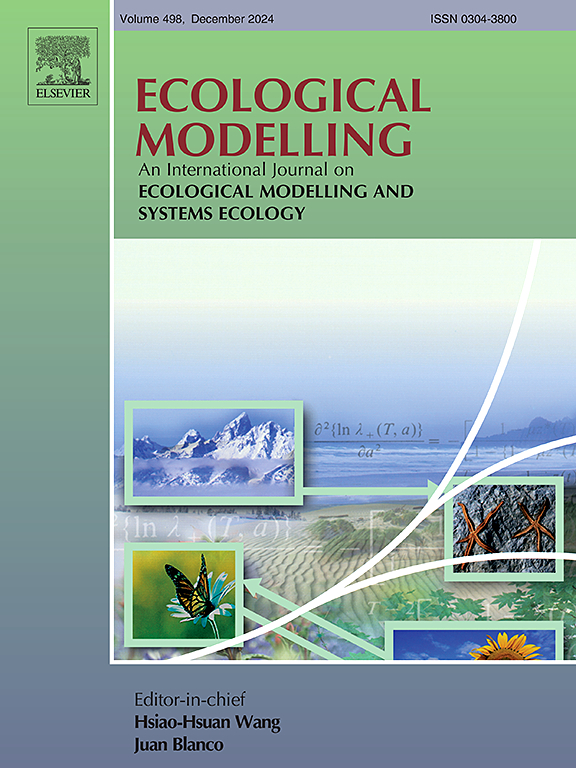硅藻-浮游动物相互作用的Holling IV型功能响应评估
IF 3.2
3区 环境科学与生态学
Q2 ECOLOGY
引用次数: 0
摘要
在海洋生态系统中,硅藻和浮游动物之间的捕食相互作用是碳从初级生产者向更高营养水平转移的关键过程。这种关系也是生物地球化学NPZ(氮-浮游植物-浮游动物)模型的基本组成部分。这种关系的数学模型被称为捕食者摄食率作为猎物浓度函数的功能反应,尽管这种关系所涉及的生物过程及其后果是不确定的。例如,自然界的观察表明,硅藻与它们的食草动物(浮游动物)之间存在一些反馈反应,通过释放有毒化合物来减缓或抑制它们的捕食者的生长,作为一种防御机制。这种现象可能发生在高产的沿海上升流系统的硅藻春季开花期间。在本研究中,我们对该抑制因子对NPZ动力学的潜在影响进行了分析试验。我们使用基于Holling IV型泛函响应的3-微分方程组来描述NPZ分量的动力学特性,并考察了三维空间上无穷长的解的行为。NPZ模型的分析方法表明,在存在抑制参数的情况下,系统不会达到平衡,即硅藻和浮游动物保持不可预测的动态。这些发现与在智利中南部沿海站观测到的实地数据一致。因此,我们的研究表明,在高产的沿海上升流系统中,硅藻与浮游动物的关系确实存在反馈机制,并应将其纳入生物地球化学NPZ模型中。本文章由计算机程序翻译,如有差异,请以英文原文为准。
Assessing the functional response Holling type IV for the diatoms–zooplankton interaction
In the marine ecosystem, the prey–predator interaction between diatoms and zooplankton constitutes a key process for carbon transfer from primary producers to higher trophic levels. This relationship is also a fundamental component of the biogeochemical NPZ (Nitrogen–Phytoplankton–Zooplankton) models. The mathematical modeling of this relationship is known as the functional response of the predator’s feeding rate as a function of prey concentration, although the biological processes involved in this relationship and their consequences are uncertain. For instance, observations in nature suggest the existence of some feedback responses of diatoms with their grazers (zooplankton) through the release of toxic compounds that can slow down or inhibit the growth of their predators as a defense mechanism. This phenomenon may occur during the spring bloom of diatoms in highly productive coastal upwelling systems. In this study, we performed an analytical test of the potential effect of this inhibitory factor on NPZ dynamics. We used a 3-differential equation system based on the Holling IV type functional response to describe the dynamics of the NPZ components by examining the behavior of solutions in the infinite over a 3-D space. The analytical approach to NPZ modeling indicated that in the presence of an inhibitory parameter, the system does not reach equilibrium, i.e., diatoms and zooplankton maintain unpredictable dynamics. These findings were consistent with field data observed at a coastal station in central-southern Chile. Our study thus suggests that feedback mechanisms can indeed exist in the diatom–zooplankton relationship in highly productive coastal upwelling systems, and they should be incorporated into biogeochemical NPZ models.
求助全文
通过发布文献求助,成功后即可免费获取论文全文。
去求助
来源期刊

Ecological Modelling
环境科学-生态学
CiteScore
5.60
自引率
6.50%
发文量
259
审稿时长
69 days
期刊介绍:
The journal is concerned with the use of mathematical models and systems analysis for the description of ecological processes and for the sustainable management of resources. Human activity and well-being are dependent on and integrated with the functioning of ecosystems and the services they provide. We aim to understand these basic ecosystem functions using mathematical and conceptual modelling, systems analysis, thermodynamics, computer simulations, and ecological theory. This leads to a preference for process-based models embedded in theory with explicit causative agents as opposed to strictly statistical or correlative descriptions. These modelling methods can be applied to a wide spectrum of issues ranging from basic ecology to human ecology to socio-ecological systems. The journal welcomes research articles, short communications, review articles, letters to the editor, book reviews, and other communications. The journal also supports the activities of the [International Society of Ecological Modelling (ISEM)](http://www.isemna.org/).
 求助内容:
求助内容: 应助结果提醒方式:
应助结果提醒方式:


